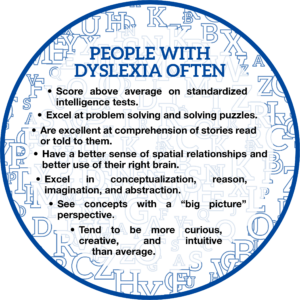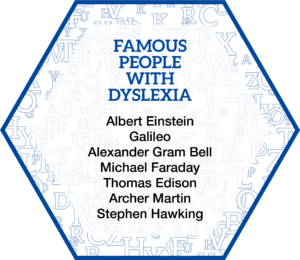OCTOBER IS DYSLEXIA AWARENESS MONTH
October 24, 2023
Presented by WET’s Diversity & Inclusion Education Committee
![]()
There is no single test that can diagnose dyslexia. Most individual diagnoses are determined based on several assessments implemented by educators, physicians, neurologists, and psychologists. In general, these will examine:
Background Information
Including childhood development, family history, educational history, and previous intervention (if applicable).
Oral Language Skills
Including tests that demonstrate High-Level Oral Language Skills (understanding spoken directions, carrying a conversation, and word use), and Phonological Processing Skills (the ability to identify, pronounce, and recall sounds).
Reading Tests
Including tests for word recognition, word decoding, spelling, reading comprehension, and vocabulary knowledge.
Automaticity and Fluency Skills
Includes tests on information processing speeds.
This summary of diagnosis methods for dyslexia was extracted from the International Dyslexia Association’s Website. For a more in-depth review of this resource please follow the link provided HERE.
![]()
The Federal Government formally recognizes dyslexia as a learning disorder through the US Department of Justice’s American Disability Act (ADA). The ADA requires schools to provide adequate screening for students with potential learning disabilities such as dyslexia and to provide reasonable accommodations for students diagnosed with learning disabilities including Individual Education Programs (IEP) or a 504 Plan. These accommodations come in various forms and are designated based on a student’s needs. The ADA also requires workplaces to provide “Reasonable Accommodations” for employees with disabilities, some of which are previously mentioned in this article.
Montana passed the Montana Dyslexia Screening and Intervention Act (Senate Bill No. 140) in 2019. This act addresses dyslexia in Montana, providing a definition of dyslexia and reiterating the existing obligation of school districts to identify students with dyslexia and evaluate them for special education and related services. Follow the link to read the Montana Legislature HERE.
Wyoming passed the Dyslexia Screening and Response as part of Senate File No. SF0052. This legislation requires that, “Each school district shall design and implement a reading screening program that measures student reading progress and attempts to identify dyslexia and other reading difficulties as early as possible in kindergarten through grade three (3).” It also requires that, “the program shall be multi-tiered and shall include various interventions to encourage remediation of any reading difficulty as early as possible.” Follow the link to read the Wyoming Legislature HERE.
![]()
Dyslexia is one of the most common learning disabilities in the United States, affecting approximately 20 percent of the population. With this statistic in mind, we can assume that approximately 20 WET employees struggle with symptoms associated with dyslexia and many more have family members, friends and associates that are affected by the disability. The mission of the Diversity & Inclusion Team is to improve cultural understanding and acceptance within WET; ultimately making the company a better place to work. This article is designed to provide information and resources related to Dyslexia to our fellow WET employees.
![]()
Dyslexia is a specific learning disability that is neurobiological in origin. It is characterized by difficulties with accurate or fluent word recognition and by poor spelling and decoding abilities. These difficulties typically result from a deficit in the phonological component of language that is often unexpected in relation to other cognitive abilities and the provision of effective classroom instruction. Secondary consequences may include problems in reading comprehension and reduced reading experience that can impede growth of vocabulary and background knowledge (International Dyslexia Association).
Dyslexia is a learning disorder that involves difficulty reading due to problems identifying speech sounds and learning how they relate to letters and words (decoding). Also called a reading disability, Dyslexia is a result of individual differences in areas of the brain that process language (Mayo Clinic).
The Word Dyslexia is derived from the Greek word, dys, meaning poor or inadequate, and the word lexis, meaning words or language. Dyslexia is a learning disorder characterized by problems in processing words into meaningful information. This is most strongly reflected in difficulty in learning to read (Medical Dictionary).
![]()
The symptoms of dyslexia provided in this section were taken from the Mayo Clinic’s Patient Care & Health Information Website. To review these symptom and other information on dyslexia follow the link provided HERE.
Signs that a young child, aged 1 through 5, may be at risk of dyslexia include:
- Late talking.
- Learning new words slowly.
- Problems forming words correctly, such as reversing sounds in words or confusing words that sound alike.
- Problems remembering or naming letters, numbers, and colors.
- Difficulty learning nursery rhymes, songs, or playing rhyming games.
Signs that a child aged 5 through 12, may be at risk of dyslexia include:
- Reading below the expected level for age.
- Problems processing and understanding what is heard.
- Difficulty finding the right word or forming answers to questions.
- Problems remembering the sequence of things.
- Difficulty seeing (and occasionally hearing) similarities and differences in letters and words.
- Inability to sound out the pronunciation of an unfamiliar word.
- Difficulty spelling.
- Spending an unusually long-time completing tasks that involve reading or writing,
- Avoiding activities that involve reading.
Signs that teens and adults may be at risk of dyslexia include:
- Difficulty reading, including reading aloud.
- Slow and labor-intensive reading and writing.
- Problems with spelling.
- Avoiding activities that involve reading.
- Mispronouncing names or words, or problems retrieving words.
- Spending an unusually long-time completing tasks that involve reading or writing.
- Difficulty summarizing a story.
- Trouble learning a foreign language.
- Difficulty doing math word problems.
![]()
There is no know way to correct the underlying brain differences that cause dyslexia. However, early detection and evaluation to determine specific needs and appropriate treatment can improve success in overcoming dyslexia.
Early intervention is a critical component to overcoming dyslexia. Educators may use varying techniques based on the student’s specific dyslexia deficiencies. These techniques may include hearing, vision, and touch techniques designed to improve reading skills through allowing students to use several senses to learn. They are designed to help students with dyslexia improve skills associated with understanding phonemes, phonics, reading comprehension, fluency, and vocabulary.
Often the supports that aid children with dyslexia will also be effective for adults, however, their life situation will be different. Dyslexic adults will need to navigate the workplace, the community, and the responsibilities of daily living. Below are some suggestions to aid in adapting for dyslexic adults.
Adapting Printed Material for Dyslexic Persons
- Justified text is difficult to read for many dyslexic adults, as it creates uneven spaces between letters and words. Use left-aligned text rather than justified text for better accessibility.
- Evenly spaced fonts such as Arial, Tahoma, Helvetica, Geneva, Verdana, Century-Gothic, and Trebuchet in 12-to-14-point font are all easier for a dyslexic person to read.
- Avoid long blocks of unbroken text. Instead, use short paragraphs, limiting each paragraph to one idea.
- Dark-colored text on light-colored background is easier to read. Avoid green, red, or pink font as these are likely harder to read for most dyslexics.
- Select paper that is thick enough so that you cannot see through it to the other printed side of the page. Use matte paper rather than glossy.
- Provide clear written directions. Use short sentences written in direct style and be concise.
- Provide information in bullet points, or numbered lists, rather than dense paragraphs.
Make Use of Technology
- Provide speech-to-text software that allows dyslexic adults to generate ideas by speaking rather than writing. This software can aid in dictating emails, drafting reports, or surfing the internet using voice commands.
- Provide text-to-speech software that allows dyslexic adults to obtain written information translated to speech sounds.
For more information on how to aid dyslexic adults in the workplace please visit the link provided HERE.







